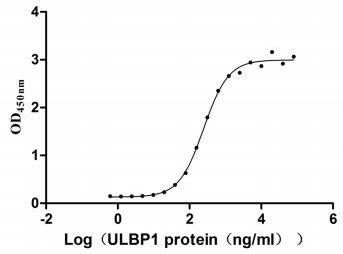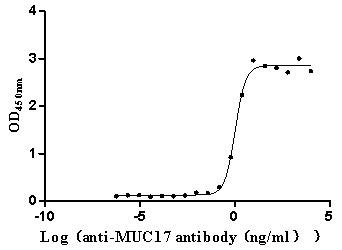Recombinant Human Exostosin-1 (EXT1), partial
-
货号:CSB-YP620959HU
-
规格:
-
来源:Yeast
-
其他:
-
货号:CSB-EP620959HU
-
规格:
-
来源:E.coli
-
其他:
-
货号:CSB-EP620959HU-B
-
规格:
-
来源:E.coli
-
共轭:Avi-tag Biotinylated
E. coli biotin ligase (BirA) is highly specific in covalently attaching biotin to the 15 amino acid AviTag peptide. This recombinant protein was biotinylated in vivo by AviTag-BirA technology, which method is BriA catalyzes amide linkage between the biotin and the specific lysine of the AviTag.
-
其他:
-
货号:CSB-BP620959HU
-
规格:
-
来源:Baculovirus
-
其他:
-
货号:CSB-MP620959HU
-
规格:
-
来源:Mammalian cell
-
其他:
产品详情
-
纯度:>85% (SDS-PAGE)
-
基因名:EXT1
-
Uniprot No.:
-
别名:4-alpha-N-acetylglucosaminyltransferase; exostoses (multiple) 1; Exostosin 1; Exostosin glycosyltransferase 1; Exostosin-1; EXT; EXT1; EXT1_HUMAN; Glucuronosyl-N-acetylglucosaminyl-proteoglycan/N-acetylglucosaminyl-proteoglycan 4-alpha-N-acetylglucosaminyltransferase; glucuronosyl-N-acetylglucosaminyl-proteoglycan/N-acetylglucosaminyl-proteoglycan; Langer-Giedion syndrome chromosome region; LGCR; LGS; Multiple exostoses protein 1; Multiple exostoses protein 1 homolog ; N-acetylglucosaminyl-proteoglycan 4-beta-glucuronosyltransferase; Putative tumor suppressor protein EXT1; TRPS2; TTV
-
种属:Homo sapiens (Human)
-
蛋白长度:Partial
-
蛋白标签:Tag type will be determined during the manufacturing process.
The tag type will be determined during production process. If you have specified tag type, please tell us and we will develop the specified tag preferentially. -
产品提供形式:Lyophilized powder
Note: We will preferentially ship the format that we have in stock, however, if you have any special requirement for the format, please remark your requirement when placing the order, we will prepare according to your demand. -
复溶:We recommend that this vial be briefly centrifuged prior to opening to bring the contents to the bottom. Please reconstitute protein in deionized sterile water to a concentration of 0.1-1.0 mg/mL.We recommend to add 5-50% of glycerol (final concentration) and aliquot for long-term storage at -20℃/-80℃. Our default final concentration of glycerol is 50%. Customers could use it as reference.
-
储存条件:Store at -20°C/-80°C upon receipt, aliquoting is necessary for mutiple use. Avoid repeated freeze-thaw cycles.
-
保质期:The shelf life is related to many factors, storage state, buffer ingredients, storage temperature and the stability of the protein itself.
Generally, the shelf life of liquid form is 6 months at -20°C/-80°C. The shelf life of lyophilized form is 12 months at -20°C/-80°C. -
货期:Delivery time may differ from different purchasing way or location, please kindly consult your local distributors for specific delivery time.Note: All of our proteins are default shipped with normal blue ice packs, if you request to ship with dry ice, please communicate with us in advance and extra fees will be charged.
-
注意事项:Repeated freezing and thawing is not recommended. Store working aliquots at 4°C for up to one week.
-
Datasheet :Please contact us to get it.
相关产品
靶点详情
-
功能:Glycosyltransferase required for the biosynthesis of heparan-sulfate. The EXT1/EXT2 complex possesses substantially higher glycosyltransferase activity than EXT1 or EXT2 alone. Appears to be a tumor suppressor. Required for the exosomal release of SDCBP, CD63 and syndecan.
-
基因功能参考文献:
- The present study identified pathogenic mutations in 93% (68/73) of unrelated hereditary multiple osteochondromasprobands from 73 pedigrees. Mutations in EXT1 and EXT2 were identified in 53% (39/73) and 40% (29/73) of families. PMID: 30334991
- Exons and flanking regions of the EXT1 and EXT2 genes were analyzed from the genomic DNA of 153 patients in 114 families with multiple osteochondromas. We identified 33 variants in EXT1 (13 frameshift, 11 nonsense, 5 missense, 2 splice site mutation, and 2 large deletions) in and 17 (6 frameshift, 6 splice site mutation, 3 nonsense, 1 missense, and 1 large deletion) in EXT2 gene. Of all 50 variants, 31 (62%) were novel. PMID: 29529714
- RT-PCR analysis showed that the overall transcriptional activity of the main Heparan Sulfate biosynthesis-involved genes (EXT1, EXT2, NDST1, NDST2, GLCE, HS2ST1, HS3ST1, HS3ST2, HS6ST1, HS6ST2, SULF1, SULF2, HPSE) was decreased by 1.5-2-fold in Grade II-III glioma. PMID: 29104277
- The nine mutations identified by targeted next-generation sequencing include two missense mutations (EXT1: c.1088G>A and c.2120C>T), one splicing mutation (EXT2: c.744-1G>T) PMID: 28690282
- A novel heterozygous frameshift mutation was found in exon 4 of the exostosin-1 (EXT1) gene in the proband and the other 6 hereditary multiple exostosis (HME) affected individuals. PMID: 29419870
- EXT1, a gene not previously linked to acute lymphoblastic leukemia via mutations, is a common interactor of NOTCH1 and FBXW7 regulating the NOTCH pathway in an FBXW7-dependend manner. PMID: 27229929
- A novel heterozygous point mutation (c.1164+1G to A) at the 5'splice sites of intron 3 of the EXT1 gene is associated with multiple osteochondroma. PMID: 28604967
- EXT1 is up regulated in patients after chronic rhinosinusitis, developing osteitis. PMID: 27888647
- Owing to the appearance of c.335_336insA in exon 1 of exotosin 1, a premature stop codon was introduced, resulting in truncated exotosin 1. As a result integrated and functional exotosin 1 was reduced. PMID: 28035357
- We report the discovery of a non-sense mutation in EXT2 in an 11-y-old boy diagnosed with multiple osteochondroma. PMID: 25591329
- We found that the prevalence of EXT1 mutations was greater than that of EXT2 mutations in Japanese multiple osteochondromas families. PMID: 26961984
- Ext1 heterozygosity causes a modest effect on postprandial lipid clearance in humans PMID: 25568062
- EXT1 mutation is associated with multiple osteochondromatosis. PMID: 25230886
- Heterozygous loss of function of EXT1 and EXT2 results in a decreased arteriolar endothelial glycocalyx but improved flow mediated vasodilation. PMID: 25468659
- there is a putative genetic connection between TCF7L2 and EXT in the context of Hereditary Multiple Exostoses PMID: 25498973
- loss of function of EXT1 subjects with hereditary multiple exostoses affects pancreatic insulin secretion capacity and development. PMID: 25541963
- Results provide a new frameshift mutation in EXT1, further emphasizing the dysfunction of the EXT gene family as a cause of hereditary multiple exostosis. PMID: 25421355
- exostosin 1 (EXT1), which is involved in biosynthesis of heparan sulfate, plays a role in filovirus entry PMID: 25741008
- EXT1 and EXT2 heterozygous mutations in 18 (54.6 %) and ten (30.3 %) probands respectively, which represents a total of 28 (84.9 %) index cases. PMID: 24532482
- a novel disease-causing EXT1 mutation in a pedigree with Hereditary multiple exostoses PMID: 24297320
- splicing mutation, IVS5+1G>A, of EXT1, first identified in Chinese population, may be responsible for HME in the studied pedigree. EXT1 and EXT2 mutation rates may be different between the Chinese and Western populations PMID: 24568913
- Exome sequencing and functional analysis identifies a novel mutation in EXT1 gene that causes multiple osteochondromas. PMID: 24009674
- these findings are useful for extending the mutational spectrum in EXT1 and EXT2 and understanding the genetic basis of multiple osteochondromas in Chinese patients. PMID: 24120389
- Novel and recurrent mutations occur in the EXT1 and EXT2 genes in Chinese kindreds with multiple osteochondromas. PMID: 23629877
- we found a mutation in EXT1 or in EXT2 in 95% of the Spanish patients. Eighteen of the mutations were novel. PMID: 23439489
- Results indicate that intronic deletion and duplication of EXT1 as a causative mechanism for multiple osteochondromas (MO) not detected by conventional diagnostic methods. PMID: 23341036
- No mutations have been found among all exons of the EXT1 and EXT2 genes in this family. Linkage analysis is necessary for identifying the cause of this disease. PMID: 23450490
- 20 novel EXT1/EXT2 mutations and one large EXT2 deletion identified in the largest Southern Italy cohort of patients affected by hereditary multiple exostosis. PMID: 23262345
- analysis of novel pathogenic mutations in EXT1 and EXT2 that may have roles in multiple osteochondroma in Chinese patients PMID: 22820392
- A novel nonsense mutation of EXT1 gene found in patient diagnosed with multiple hereditary exostoses. PMID: 22637216
- Two novel EXT1 gene mutations were identified and no mutation was found in EXT2 gene in two families with multiple osteochodromas. PMID: 22040554
- A polymorphic G/C-SNP at -1158 bp (rs34016643) was demonstrated to be located in a USF1 transcription factor binding site, which is lost with the presence of the C-allele resulting in a ~56% increase in EXT1 promoter activity. PMID: 22037484
- Fifteen mutations and large deletions, of which nine are new, were detected in the EXT1 and EXT2 gene by sequence analysis, FISH and MLPA analysis. PMID: 21499719
- Molecular characterization of EXT1- and EXT2-deletion breakpoints in multiple osteochondroma indicates that non-allelic homologous recombination between Alu-sequences as well as NHEJ are causal and that the majority of these deletions are nonrecurring. PMID: 21703028
- Out of the 17 patient samples with previously undetected mutations, a low level of deletion of the EXT1 gene in about 10-15% of the blood cells was detected in two patients and mosaic deletion of the EXT2 was detected in one patient. PMID: 21280143
- 8 novel mutations of EXT1 and EXT2 genes among families and sporadic cases with multiple exostoses were identified. PMID: 21039224
- Loss of heterozygosity for EXT1 is associated with multiple osteochondromas. PMID: 20813973
- This heterozygous mutation in the EXT1 gene must be classified as pathogenic and can be regarded as the cause of hereditary multiple exostosis (HME) in this Chinese family. PMID: 20578942
- we found a splice site mutation in the EXT1 gene intron 5 (IVS5-2 A > G) resulting in the deletion of 9 bp of cDNA encoding three evolutionarily conserved amino acid residues. This child patient suffered from a severe form of exostoses. PMID: 20618940
- results clearly indicate that, in most cases, biallelic inactivation of EXT genes does not account for osteochondromas formation; this mechanism should be regarded as a common feature for hereditary osteochondromas transformation PMID: 20418910
- A novel EXT1 gene mutation causing hereditary multiple exostoses occurred in a Chinese family. PMID: 20025490
- Two novel EXT1 gene mutations and two novel EXT2 gene mutations were identified in two and three hereditary multiple exostoses pedigrees, respectively. PMID: 19839753
- deletion mutation of EXT1 is associated with autism in two patients with hereditary multiple exostoses PMID: 12032595
- EXT1 alone and the EXT1/2 heterocomplex can act as heparan sulfate polymerases in vitro without the addition of additional auxiliary proteins PMID: 12907669
- EXT1 function is abrogated in human cancer cells by transcriptional silencing associated with CpG island promoter hypermethylation. The epigenetic inactivation of EXT1, a glycosyltransferase, leads to the loss of heparan sulfate synthesis PMID: 15385438
- Variations in EXT1 gene is associated with multiple osteochondromas PMID: 15586175
- Promoter methylation was not detected in any of the chondrosarcoma cases in EXT1. PMID: 15796962
- ANovel heterozygous acceptor splice site mutation of EXT1 results in hereditary multiple exostosis(HME) associated with low peak bone mass. Possible additional role for EXT1 in bone biology and in regulating bone density. PMID: 15985493
- analysis of multiple osteochondroma-related mutations in EXT1 and EXT2 PMID: 16088908
- We found three novel mutations (S277X in the EXT1 gene, and G194X and 939+1G>A in the EXT2 gene) and a known mutation (Q172X in the EXT2 gene)in hereditary multiple exostoses PMID: 16638657
显示更多
收起更多
-
相关疾病:Hereditary multiple exostoses 1 (EXT1); Tricho-rhino-phalangeal syndrome 2 (TRPS2); Chondrosarcoma (CHDSA)
-
亚细胞定位:Endoplasmic reticulum membrane; Single-pass type II membrane protein. Golgi apparatus membrane; Single-pass type II membrane protein. Note=The EXT1/EXT2 complex is localized in the Golgi apparatus.
-
蛋白家族:Glycosyltransferase 47 family
-
组织特异性:Ubiquitous.
-
数据库链接:
HGNC: 3512
OMIM: 133700
KEGG: hsa:2131
STRING: 9606.ENSP00000367446
UniGene: Hs.492618
Most popular with customers
-
Recombinant Human NKG2-D type II integral membrane protein (KLRK1), partial (Active)
Express system: Mammalian cell
Species: Homo sapiens (Human)
-
Recombinant Human Prolactin receptor (PRLR), partial (Active)
Express system: Mammalian cell
Species: Homo sapiens (Human)
-
Recombinant Human Angiopoietin-2 (ANGPT2) (Active)
Express system: Mammalian cell
Species: Homo sapiens (Human)
-
Recombinant Human Mucin-17 (MUC17), partial (Active)
Express system: Mammalian cell
Species: Homo sapiens (Human)
-
Recombinant Human Cadherin-6(CDH6),partial (Active)
Express system: Mammalian cell
Species: Homo sapiens (Human)
-
Recombinant Human C-C chemokine receptor type 5 (CCR5)-VLPs (Active)
Express system: Mammalian cell
Species: Homo sapiens (Human)




-AC1.jpg)













